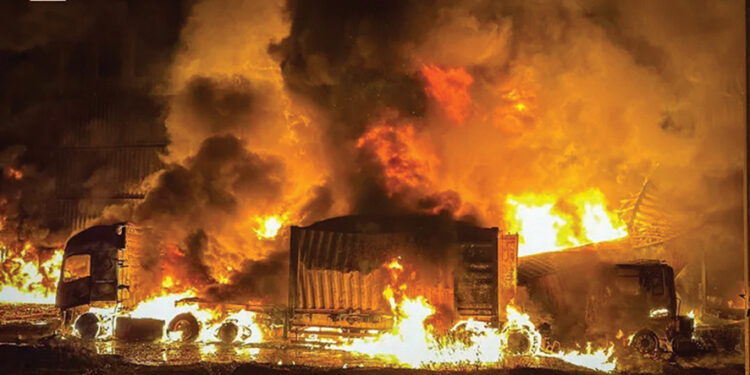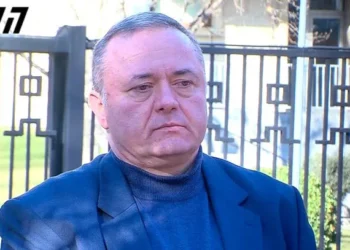The war in Ukraine is entering a new phase — slower, more punishing, and increasingly shaped by drones, power cuts, and long-range strikes rather than sweeping offensives. Neither side is making big moves on the ground, but the intensity of the fighting is growing, and the human cost is mounting by the day.
This week, Ukrainian military intelligence (HUR) revealed that at least 1,076 Cuban nationals have fought or are currently fighting alongside Russian forces in Ukraine. Of these, 96 are confirmed dead or missing in action. Recruitment tactics reportedly involve luring fighters with promises of construction work via social media, arranging travel via intermediaries, and issuing tourist or work visas through Russian diplomatic channels. The recruits allegedly undergo only two weeks of training at the Avangard Center in Moscow Oblast before being sent to frontline positions. The revelation tracks the lower end of a previous US estimate that put the number of Cubans fighting for Russia between 1,000 and 5,000.
On the diplomatic and military aid front, several European nations have taken significant steps over recent days. Denmark promised $171 million in assistance, earmarked for naval needs, tank repairs, training, fuel, and rehabilitation in frontline zones. Sweden laid out plans to contribute radar-reconnaissance and early warning aircraft, potentially paving the way for deployment of Swedish Gripen fighters. Germany pledged a new package worth more than 2 billion euros (about $2.3 billion), which includes air defense systems such as Patriot and IRIS-T, precision munitions, secure communications, anti-tank weapons, and small arms. Half a billion dollars of that total will flow through NATO’s PURL (Prioritized Ukraine Requirements List) initiative. Finland and Lithuania formally joined PURL, offering financial support—$30 million from Lithuania—while the Netherlands unveiled a 90 million-euro package for drone production, and Estonia prepared fresh drone deliveries.
Simultaneously, Ukraine intensified its outreach to US defense firms. A high-level delegation, including President Zelensky’s top aides and ministers, held meetings with Raytheon and Lockheed Martin to discuss deliveries of systems such as Tomahawk cruise missiles. A senior NATO official confirmed that inbound Tomahawks would greatly expand Ukraine’s deep-strike capacity. The Kremlin has responded with threats of escalation, though many analysts believe Russia will rely on rhetorical deterrence rather than direct confrontation with NATO.
On the battlefield, the tempo of ground operations remained relatively modest this week, but the shadow war of drones, missiles, and attritional strikes on energy infrastructure has grown fiercer. Russia has shifted its posture from broad offensives to precision drone and glide bomb strikes aimed at rail, power, and gas infrastructure.
“Russia timed its recent assault on Ukraine’s energy infrastructure to coincide with poor weather, which reduced the effectiveness of Ukraine’s air defenses by 20 30 %,” said President Volodymyr Zelensky.
Since mid-2025, Moscow has escalated attacks on Ukraine’s railway lines using upgraded drones with real-time video feedback, targeting locomotives and high-value nodes to disrupt supply and aid lines. The number of such sorties has jumped from one per week to as many as ten.
This week, Ukraine launched a major counter-strike across Russian territory, hitting a Sverdlov ammunition plant in the Nizhny Novgorod region, an oil terminal in occupied Crimea, and a Russian 18th Combined Arms Army ammunition depot. Moscow claimed to have shot down 251 Ukrainian drones across 14 regions. The strikes show Kyiv’s growing capacity for long-range retaliation, relying entirely on domestically produced systems.
Moscow’s countermeasure has been its most aggressive energy campaign yet. In its largest attack to date, Russian forces launched 381 drones and 35 missiles against Ukraine’s natural gas extraction and processing facilities in Kharkiv and Poltava. Local officials described the assault as a deliberate campaign of terror designed to deprive civilians of heat and power this winter. The resulting damage forced emergency power cuts nationwide, with Ukraine instituting scheduled outages in all but two regions. Over 1.9 million users have had power restored through rapid repairs, but many remain in the dark as winter looms. Ukraine’s response now hinges on additional air defense systems, emergency energy imports, and support to restore its gas reserve capacities.
The assault wave reached even Russia’s interior. A drone struck the Ufaorgsintez refinery in Bashkortostan—over 1,300 kilometers from the frontline—triggering fires and disrupting mobile networks. In Russian-occupied Crimea, Ukraine’s drones hit the Feodosia Morskoi Neftianoi Terminal, damaging sixteen fuel tanks.
The blaze remained visible from kilometers away for days, marking the second confirmed strike on the facility within a week.
On the front, Russian forces made incremental gains. In the Kupiansk region, the village of Myrne fell to Moscow’s troops, and they pressed toward Ivanivka. Ukrainian authorities responded by expanding evacuations across 40 settlements, relocating 409 families with 601 children. In Donetsk, Russia claimed to have captured Balahan, while counterattacks in Pokrovsk and Dobropillia saw intense combat with uncertain results. Analysis suggests that Russian attacks overall have decreased this month—averaging just 11 daily assaults compared to 21—indicating a war of attrition rather than a sweeping offensive.
The toll on human life continued. Over the past day, Russian air and drone attacks killed at least 7 civilians and injured 29 across eleven Ukrainian regions. Kherson saw three deaths, including a child; Donetsk lost two civilians to strikes; in Dnipropetrovsk, a 75-year-old woman was killed by an FPV drone; and in Sumy, six more were wounded. The Ukrainian air force intercepted 86 of 113 incoming drones and missiles, yet infrastructure and lives were still lost.
With desperation growing in the occupied territories, news broke that Yevhenii Matvieiev, the abducted mayor of Dniproudne in Zaporizhzhia Oblast, died in Russian custody in 2024 from severe blunt-force trauma. Matvieiev was seized in 2022 and long presumed missing. His repatriated remains now fuel ongoing investigations by Ukraine’s Security Service.
Meanwhile, the human and material cost on Russia is being continuously recalculated by Kyiv’s General Staff. Since the invasion began, Russia has reportedly lost 1,126,220 troops, including 1,070 in a single day. Equipment losses include over 11,000 tanks, 33,000 artillery systems, 1,227 air defense systems, 70,021 drones, and 427 aircraft. Over 23,000 armored vehicles and 64,000 transport and fuel vehicles are gone, alongside losses of helicopters, ships, and a submarine.
In Moscow, the war is exerting internal pressure. Public opinion polls suggest rising weariness: over 80 percent of Russians reportedly support ending hostilities imminently. The Kremlin is attempting to manage this discontent through tighter censorship, amplified propaganda, and elite purges. Analysts argue Russia’s modest offensives are stalling, with Ukrainian forces reclaiming territory in Sumy and mounting counterattacks across Donbas. The regime has few options besides doubling down on energy pressure runs, drone saturation, or empty saber-rattling with nuclear rhetoric.
Moscow remains obsessed with a “decisive breakthrough,” particularly in Donbas, hoping to capitalize on Ukraine exhaustion. But after repeated failures and staggering losses, many observers believe that the war is entering a protracted, pulverizing phase. If breakthroughs do not materialize by year’s end, talk of a temporary ceasefire or a reconfigured pause may reemerge. Putin is unlikely to abandon his maximalist goals entirely, but may seek a tactical regrouping should Kyiv’s resistance persist.
On the diplomatic front, the US signal from Brussels was stark: Defense Secretary Pete Hegseth warned Moscow of looming costs if hostilities continue. President Trump hinted that Tomahawks could be deployed to Ukraine to enforce pressure. But for the moment, NATO is navigating a delicate balance: bolstering Ukraine without triggering direct confrontation.
In other news, Ukraine has intensified calls for global accountability as evidence mounts that Russia is systematically abducting, Russifying, and re educating kidnapped Ukrainian children. A Yale Humanitarian Research Lab report alleges more than 200 facilities across Russia and occupied Ukrainian territory are used to house deported children for political indoctrination and even military training. Kyiv claims it has verified 19,546 children forcibly transferred, though it argues the true figure is much higher. In response, Andriy Yermak, President Zelenskiy’s chief of staff, announced a recent success: “Twenty three Ukrainian children and adolescents have been brought out of Russian occupied areas” under Kyiv’s Bring Kids Back UA program.
Despite rare returns, many children remain out of reach, while Russia dismisses foreign reports as propaganda. In September, Moscow rejected Yale’s findings, calling them “unscientific” and claiming the list of 339 children—submitted in peace talks—was inflated. Ukrainian officials reject such denials. Deputy Foreign Minister Mariana Betsa said: “Russia erases their identity … many of them do not even remember their parents.” Kyiv insists that the unconditional return of all abducted children must be a red line in any negotiations, labeling the abductions a distinct war crime under the Geneva Conventions and potentially a genocidal act under the Genocide Convention’s provisions on forcible transfer of children.
Compiled by Ana Dumbadze














